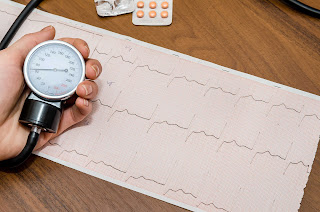Systolic and diastolic blood pressure
https://pulse-tao.blogspot.com/2020/01/systolic-and-diastolic-blood-pressure.html
According to the World Health Organization WHO, hypertension is one of the most common causes of death in humans. Knowing and controlling blood pressure indices helps minimize the risk of complications caused by blood pressure diseases. The following article will help you better understand diastolic blood pressure vs systolic blood pressure.
The unit of measurement of blood pressure is millimeters of mercury (mmHg). Blood pressure is determined by two indicators, usually written as a ratio. The first index (or the upper index) is the systolic blood pressure, the second index (or the lower index) is the diastolic blood pressure.
Diastolic blood pressure is the lowest level of blood pressure in the blood vessels
Related content: High Systolic Blood Pressure Symptoms - Qigong Solution
What many people don't know is how they can affect their hypertension by exercising. Medical research has found that several types of exercise can lower arterial pressure just as, or more effectively than some medications. This generally happens for several reasons.
But, generally, exercise causes your arteries to dilate which, in turn, lowers blood pressure. If these exercises are performed consistently over a period of time, the pressure tends to stay low and many people can actually stop taking their medications.
One of these studies done at Cantebury Christ Church University in England looked at the effects that isometric exercises had on blood pressure. This study was divided into 2 groups. The first group did low intensity isometrics, and the second group did high intensity isometrics.
Both groups did 4 reps of exercises for 2 minutes in duration 3 times a week for 8 weeks. And both groups demonstrated a significant reduction with the high intensity group having the largest reduction in pressure.
Another study at Texas A&M University looked at the effects that riding a stationary bike had on blood pressure. They also found that this lowered blood pressure. Especially during the exercise. The participants in this study rode stationary bikes 3 times a week for 6 weeks. The intensity of the exercise was increased at regular intervals. What researchers found was that the highest drops in blood pressure were seen in those with the blood pressure readings going into the study.
But it's not just with isometric and aerobic exercises, interval training also has a lowering effect also. In fact, it was found in a study at Liverpool John Moores University in England that interval training can lower blood pressure significantly almost immediately.
What these participants did was ride a stationary bike for 10 minutes and then rest for 10 minutes. They did this at 8 o'clock in the morning and then again at 2pm to see if there was a difference with the lowering effects of exercise. What they found was that interval exercises done in the afternoon had more of an effect on on it than in the morning.
All of these studies suggest that along with traditional approaches to treating high blood pressure with medications, it may well be worth asking your doctor if you are healthy enough to start participating in a regular exercise program to help lower your pressure. And, for those who are interested in prevention of hypertension, adopting a regular home exercise program might be on of the better things to do.
Related content: High Systolic Blood Pressure - Exercises and Electronic Help Tools
What is diastolic blood pressure? What is the normal, low and high index?
1. What is blood pressure?
Blood is carried from the heart to all parts of the body through arteries and veins. Each time the heart beats, the heart pumps blood throughout the body. Blood pressure is created by the force of blood against the inner walls of blood vessels as the heart pumps blood throughout the body.The unit of measurement of blood pressure is millimeters of mercury (mmHg). Blood pressure is determined by two indicators, usually written as a ratio. The first index (or the upper index) is the systolic blood pressure, the second index (or the lower index) is the diastolic blood pressure.
2. What is diastolic blood pressure?
Diastolic blood pressure is the lowest level of blood pressure in the blood vessels and occurs between heart contractions, when the heart muscle is relaxed.Diastolic blood pressure is the lowest level of blood pressure in the blood vessels
3. How much is good for diastolic blood pressure?
To diagnose whether a person's blood pressure is normal or not, one is based on both systolic and diastolic blood pressure values:
- Normal adult blood pressure is defined as a systolic blood pressure of 120 mmHg and a diastolic pressure of 80 mmHg;
- Hypertension is defined as having systolic blood pressure of 140 mmHg or more and / or diastolic blood pressure of 90 mmHg or more;
- The difference in systolic and diastolic blood pressure holds a certain difference to create perfusion pressure for the organs. However, this difference should never be equal to or below 20 mmHg. If below this number, the doctor will identify this as a case of clamping blood pressure and will conduct emergency treatment.
- Normal systolic and diastolic blood pressure levels are particularly important for the efficient functioning of vital organs such as the heart, brain and kidneys, and for general health.
4. What is high diastolic blood pressure?
Diastolic hypertension is defined as diastolic pressure of 90mmHg or more. Solitary diastolic hypertension is primarily seen in young people. In most people with isolated diastolic hypertension no specific cause is identified, also known as primary hypertension. In rare cases, isolated diastolic hypertension is secondary to another disorder such as thyroid disease, kidney disease or sleep apnea syndrome.
When diastolic blood pressure is high, blood vessels become less elastic, stiff and atherosclerotic. Normal diastolic blood pressure usually ranges from 60 - 80mmHg. If your diastolic blood pressure is 80 - 89 mmHg, pay special attention because you are in the pre-hypertensive stage.
Diastolic pressure often changes throughout the day. You should check your blood pressure several times a day to get an average. Even when there is no other progression, diastolic hypertension alone increases the likelihood of serious cardiovascular complications.
High Systolic Low Diastolic Blood Pressure - What happens? Solution!
1. Systolic blood pressure
Blood pressure is determined by two indicators, usually written as ratios. The first is the systolic number and the second is the diastolic blood pressure.
The systolic pressure or the upper index is the highest level of blood pressure in the blood vessels, which occurs when the heart contracts.
Diastolic blood pressure or the lower index is the lowest level in the blood vessels and occurs between heart contractions, when the heart muscle is relaxed.
Related content: High Systolic Blood Pressure Symptoms - Qigong Solution
2. Determine blood pressure by systolic and diastolic blood pressure
- Normal blood pressure: When the systolic blood pressure index is less than 120mmHg and the diastolic blood pressure is below 80mmHg.
- High blood pressure: When the systolic blood pressure reading is greater than 140 mmHg and the diastolic pressure is greater than 90 mmHg.
- Prehypertension: When the systolic blood pressure index is between 120 - 139 mmHg or diastolic blood pressure between 80 - 89 mmHg.
- Low blood pressure: Diagnosed when the systolic blood pressure is below 90 mmHg or decreased by 25 mmHg compared to normal.
There are many cases where only 1 index, especially systolic blood pressure, is known as solitary hypertension.
3. High Systolic Low Diastolic Blood Pressure - What happens? Solution!
High Systolic Low Diastolic Blood Pressure:
Solution:
Blood Pressure Exercises
The effectiveness of our exercises has been proven by numerous studies. Thousands of people have benefited from them.
They’re:
More Details: The Blood Pressure Exercises
On this page, I’ll explain the three blood pressure exercises in details. And how exactly you can use them to reverse your blood pressure- starting today.
The effectiveness of our exercises has been proven by numerous studies. Thousands of people have benefited from them.
They’re:
- Effective
- Easy
- Quick
On this page, I’ll explain the three blood pressure exercises in details. And how exactly you can use them to reverse your blood pressure- starting today.
Most importantly, they have NO side effects!
What many people don't know is how they can affect their hypertension by exercising. Medical research has found that several types of exercise can lower arterial pressure just as, or more effectively than some medications. This generally happens for several reasons.
But, generally, exercise causes your arteries to dilate which, in turn, lowers blood pressure. If these exercises are performed consistently over a period of time, the pressure tends to stay low and many people can actually stop taking their medications.
One of these studies done at Cantebury Christ Church University in England looked at the effects that isometric exercises had on blood pressure. This study was divided into 2 groups. The first group did low intensity isometrics, and the second group did high intensity isometrics.
Both groups did 4 reps of exercises for 2 minutes in duration 3 times a week for 8 weeks. And both groups demonstrated a significant reduction with the high intensity group having the largest reduction in pressure.
Another study at Texas A&M University looked at the effects that riding a stationary bike had on blood pressure. They also found that this lowered blood pressure. Especially during the exercise. The participants in this study rode stationary bikes 3 times a week for 6 weeks. The intensity of the exercise was increased at regular intervals. What researchers found was that the highest drops in blood pressure were seen in those with the blood pressure readings going into the study.
But it's not just with isometric and aerobic exercises, interval training also has a lowering effect also. In fact, it was found in a study at Liverpool John Moores University in England that interval training can lower blood pressure significantly almost immediately.
What these participants did was ride a stationary bike for 10 minutes and then rest for 10 minutes. They did this at 8 o'clock in the morning and then again at 2pm to see if there was a difference with the lowering effects of exercise. What they found was that interval exercises done in the afternoon had more of an effect on on it than in the morning.
All of these studies suggest that along with traditional approaches to treating high blood pressure with medications, it may well be worth asking your doctor if you are healthy enough to start participating in a regular exercise program to help lower your pressure. And, for those who are interested in prevention of hypertension, adopting a regular home exercise program might be on of the better things to do.
Related content: High Systolic Blood Pressure - Exercises and Electronic Help Tools






I started on COPD Herbal treatment from Ultimate Life Clinic, the treatment worked incredibly for my lungs condition. I used the herbal treatment for almost 4 months, it reversed my COPD. My severe shortness of breath, dry cough, chest tightness gradually disappeared. Reach Ultimate Life Clinic via their website www.ultimatelifeclinic.com . I can breath much better and It feels comfortable!
ReplyDelete